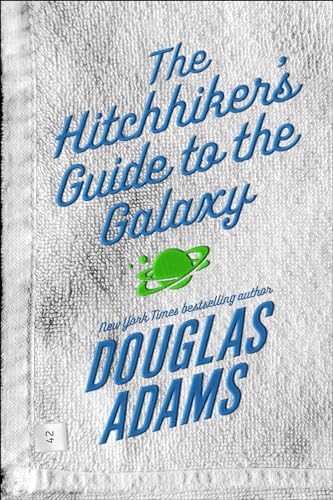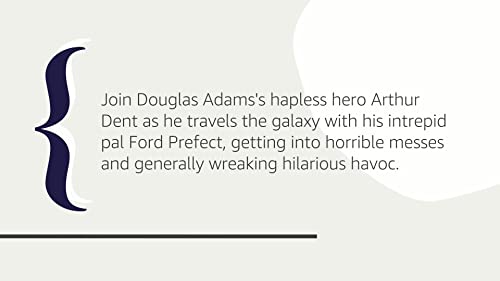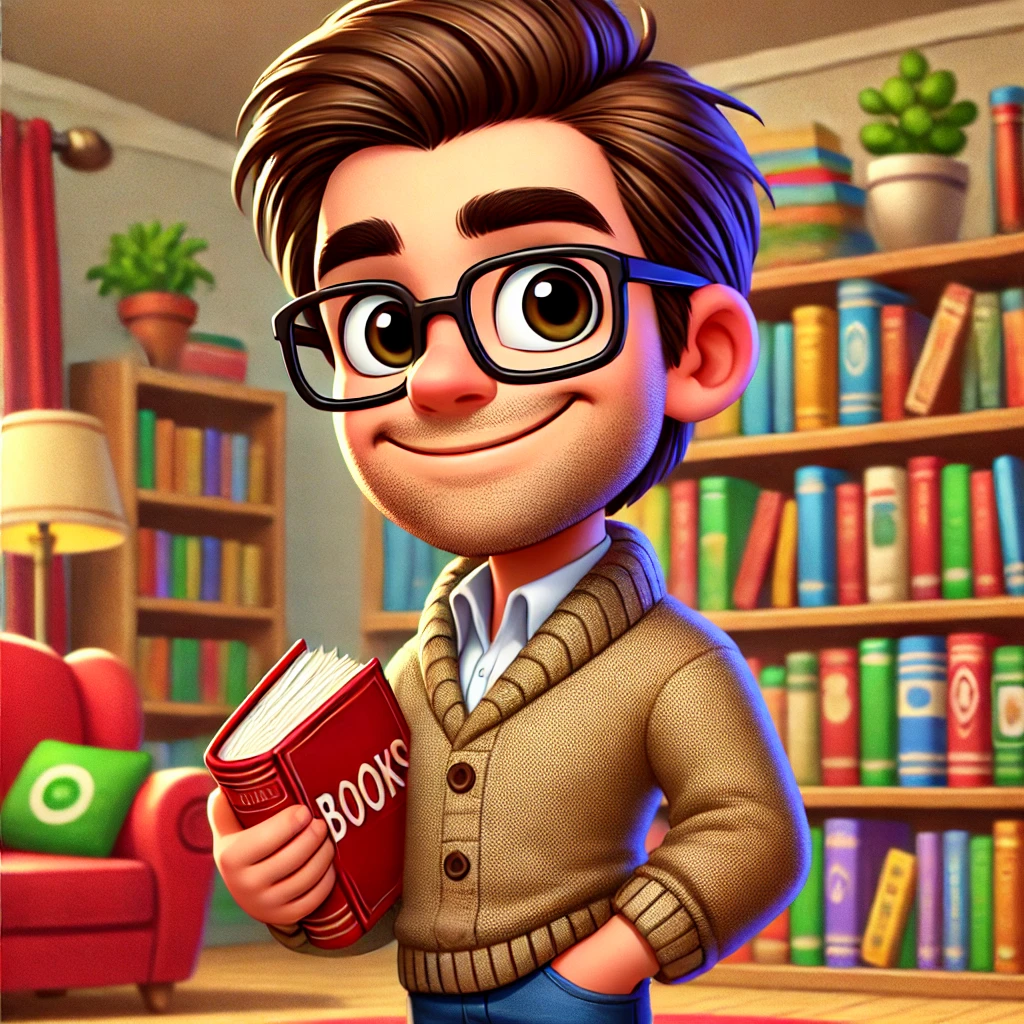Welcome to my review of the “Hitchhiker’s Guide to the Galaxy”. This book combines quirky characters, humor, and an unpredictable plot to deliver a unique reading experience. Let’s see if these elements make it a must-read or if it falls short in any areas.
In a nutshell
The Hitchhiker’s Guide to the Galaxy, penned by Douglas Adams, is a rib-tickling science fiction adventure. This quirky book explores themes of absurdity, the meaning of life, and human nature. The story follows Arthur Dent, an unwitting Englishman, who ends up hitchhiking through the galaxy. He’s joined by a series of eccentric characters, including Ford Prefect and Zaphod Beeblebrox. Together, they navigate a universe that’s as baffling as it is humorous. It’s a wild ride through space that’ll tickle your funny bone while making you ponder life’s big questions.
Exploring Humor and Wit in “Hitchhiker’s Guide to the Galaxy”
When I first picked up “Hitchhiker’s Guide to the Galaxy”, I wasn’t sure what to expect. I’d heard people rave about its humor, only to find myself laughing uncontrollably on a public train. Embarrassing yet worth it! The book is a roller-coaster ride filled with absurdity and wit that only Douglas Adams could concoct. Humor here isn’t just an add-on; it’s baked into every donut—er, I mean, every page.
There’s this scene where Zaphod Beeblebrox, with two heads and a penchant for trouble, makes a grand entrance like he’s the lead singer of the universe’s best rock band. His over-the-top antics contrast beautifully with the deadpan delivery of Marvin the Paranoid Android, whose sarcasm could deflate even the sunniest optimist. It’s like watching a perfectly choreographed dance routine where both partners are flopping around, yet somehow it all syncs.
Adams’ wit isn’t just for giggles, though. It pokes fun at human nature, bureaucracy, and even existential crises. There’s a sense of familiarity when characters navigate ridiculous situations similar to the ones we face daily, though possibly not involving hyper-intelligent dolphins.
“Hitchhiker’s Guide to the Galaxy” thrives on its ability to find humor in the most unlikely places, like the concept of a towel being your best friend in the universe. It’s wiser than my last fortune cookie.
Speaking of wisdom, prepare yourself for an exploration into the characters that make this book more than just a laugh-out-loud read. Next, I’ll delve into character development, peeling back the layers of their quirky personalities.
Quirky Characters in Hitchhiker’s Guide to the Galaxy
In Hitchhiker’s Guide to the Galaxy, Douglas Adams creates characters that are as quirky as a room full of cats on caffeine. I mean, seriously, who else introduces you to a manic-depressive robot and a two-headed, three-armed ex-President of the Galaxy? It’s like my last family reunion—full of unexpected surprises and a lot of laughs.
Arthur Dent, the Earthling in a bathrobe, is both your average Joe and the hero you didn’t know you needed. He feels like the guy you’d meet at the pub, just trying to get a pint and accidentally ending up in a space opera. Trillian, the brilliant and adventurous woman who’s actually from Earth but ends up on a spaceship, is more like that friend who always finds a way into the VIP section at a concert. Adams hooks you with characters that feel both absurd and relatable, making you care about their ridiculous adventures.
Marvin, the robot, sees the world through a lens of hilarious gloom, offering comic relief while echoing the melodramatic teen phase we all try to forget. Meanwhile, Zaphod Beeblebrox, with his charming chaos, feels like the life of the party who might accidentally set the curtains on fire. These characters don’t necessarily evolve in a traditional sense but rather deepen as the narrative unfolds, exposing layers that keep readers engaged. It’s character development with a twist, like expecting chips with dinner but getting a surprise ice cream sundae instead.
Let’s not forget Ford Prefect, the Galactic hitchhiker who researches Earth like an alien anthropologist. With a thirst for exploration, he introduces Arthur to the vast and bizarre universe beyond his morning tea. These characters aren’t just figures on a page—they’re vivid, wacky, and a bit like a kaleidoscope of your craziest ideas. Next up, we’re speeding our spaceship towards the heart of the tale as we unravel plot and story pacing. Fasten your seatbelts!
Plot and Story Pacing in Hitchhiker’s Guide to the Galaxy
The plot of Hitchhiker’s Guide to the Galaxy is like a rollercoaster ride through a fun house filled with space aliens, improbable events, and a talking computer with a personality crisis. Douglas Adams takes readers on a journey that starts on Earth but quickly blasts off to explore the galaxy, with unpredictability around every corner. I remember picking up the book, thinking I’d read a chapter before bed, and before I knew it, the sun was coming up, and I had traveled across the universe with Arthur Dent and Ford Prefect.
The pacing is brisk, never giving you a chance to catch your breath—or question why a paranoid android is your fellow traveler. It’s filled with unexpected twists and turns that kept me turning the pages faster than a Vogon poetry reading could clear a room. Adams manages to balance the fast pace with enough detail and quirkiness to keep the reader engaged without feeling overwhelmed. In fact, the pace feels as though it mirrors my own experience of trying to find my car keys in the morning—frantic, a little crazy, but eventually satisfying.
However, the quick pacing can sometimes leave readers feeling a bit lost, especially with so many different locations and bizarre characters introduced in rapid succession. But let’s be honest, who doesn’t enjoy a little chaos in their intergalactic adventures? This pace is part of what makes the book an ‘unputdownable’ experience, albeit sometimes at the expense of clarity.
Overall, the plot and pacing of Hitchhiker’s Guide to the Galaxy offer a wild ride that keeps you engaged and entertained throughout. Now, let’s engage our improbability drives and zoom into the next section: the book’s cultural impact and the countless references it has inspired. Buckle up!
Cultural Impact and Influential References from the “Hitchhiker’s Guide to the Galaxy”
“Hitchhiker’s Guide to the Galaxy” isn’t just a book; it’s a cultural phenomenon that left an imprint deeper than a crater on Mars. When Douglas Adams penned this masterpiece, he probably didn’t expect it to become a beacon of sci-fi satire and a reference point for any geek worth their salt. This book taught us that carrying a towel isn’t just for obsessive beach-goers, but a universal symbol of preparedness and wisdom. I tried this once, casually draping a towel over my shoulder during a camping trip. My friends asked if I planned to do laundry in the woods. I just gave them a knowing wink. They didn’t get it, but I felt cool.
The term “Don’t Panic” is now plastered across so much merchandise, you’d think it’s the go-to mantra for yoga classes. It’s Adams’ way of saying, “Chill out, enjoy the chaos,” something I attempt daily while navigating city traffic. My attempts to get my wife to adopt this mantra often results in her rolling her eyes, but hey, at least I’m consistent.
The book has slithered its way into movies, TV shows, and even tech culture. Google pays homage with Easter eggs, and seemingly normal people mysteriously celebrate “Towel Day.” Fans quote lines in the oddest situations, reminding us of its lasting influence.
Do I recommend this galactic romp? Absolutely. Hitchhike your way to the bookstore, and make sure to bring your towel. Adams’ masterpiece is a must-read for anyone with a sense of humor and the ability to ponder the universe’s mysteries. Don’t panic—just enjoy the ride.
Conclusion
Wrapping up this review, “Hitchhiker’s Guide to the Galaxy” is a hilarious ride through space. The quirky characters will tickle your funny bone while the fast-paced plot keeps you guessing. But, sometimes the humor can overshadow clarity of the story. Its cultural impact is huge, influencing tech and phrases like “Don’t Panic.” It’s a must-read for anyone who loves a good laugh with their sci-fi!



